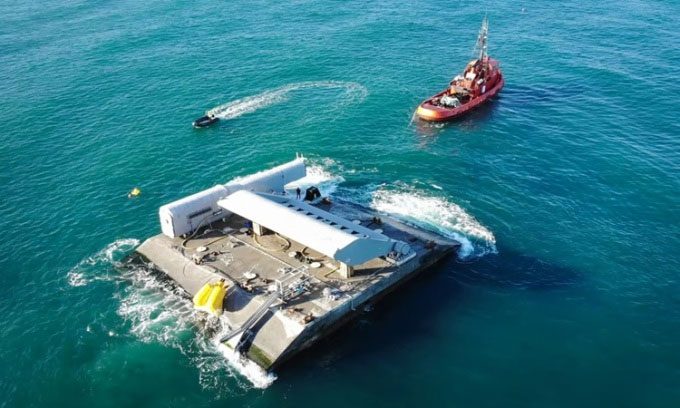AW Energy has dedicated nearly 31 years to researching, developing, and testing technology to create a wave energy generator known as “WaveRoller.” This advanced technology aims to harness energy from ocean waves to generate renewable electricity.
Wave energy is one of the least exploited clean energy options, despite its enormous potential. AW Energy from Finland is preparing to deploy large-scale WaveRoller wave energy generators on the seabed with a capacity of 1 MW, as reported by Interesting Engineering on February 4th.

The 350 kW WaveRoller prototype installed off the coast of Portugal. (Photo: AW Energy).
The concept behind WaveRoller originated in 1993 when a diver noticed a large hatch on a shipwreck moving back and forth with strong energy as waves crashed over it, sparking curiosity about whether a similar effect could be harnessed to operate hydraulic pistons and generate electricity. It wasn’t until 1999 that a proof-of-concept version was tested, and in 2005, a small-scale test farm was installed in Scotland and Ecuador. By 2016, the design was produced, assembled, tested, and licensed across Europe. Ultimately, the first commercial version of WaveRoller, with a capacity of 350 kW, was connected to the power grid in 2019, located 800 meters off the coast of Peniche, Portugal.
Two years later, the machine was brought in for testing. Part of the issue lay in the harsh marine environment, with saltwater corroding the machinery and marine growth accumulating. “We are pleased to confirm that the machine and its external components are in very good condition”, shared AW Energy.
Since 2020, AW Energy has been working on a project funded by the European Union to refine WaveRoller and related components for mass production, as well as to deploy clusters of 10 to 24 machines. These clusters, named WaveFarms, will be placed at depths of 8 to 12 meters and no more than 2 kilometers from the shore.
Each WaveRoller has a maximum capacity of 1 MW, with a projected annual electricity generation of 624 to 813 MWh per machine. In terms of levelized cost of electricity (LCoE), WaveRoller is among the most cost-competitive of the five technologies studied, with an LCoE of $100 to $150 per MWh, comparable to offshore wind energy costs of $82 to $255 per MWh in 2022.
Matthew Pech, Chief Financial Officer of AW Energy, stated that WaveRoller could provide electricity closer to base-load power plants than other renewable energy sources, helping Europe maintain its leadership in advanced renewable technology.


















































